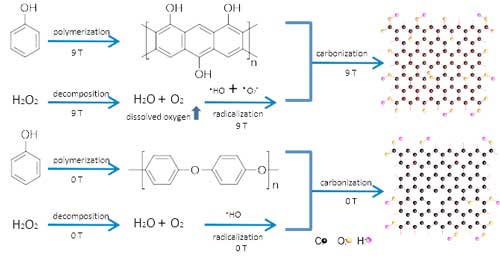| Jan 23, 2020 | |
Tuning of optical absorbance of graphene quantum dots by high magnetic fields(Nanowerk News) Recently, a Chinese research team reported (Biomaterials, "Magnetic-induced graphene quantum dots for imaging-guided photothermal therapy in the second near-infrared window") the synthesis of graphene quantum dots (GQDs) under an external high magnetic field (HMF) and their applications in photothermal therapy (PTT). |
|
 |
|
| The schematic representation of the formation of 0T-GQDs and 9T-GQDs, respectively. (Image: WANG Hui) (click on image to enlarge) | |
| GQDs plays an increasingly important role in medical areas due to tunable optical behavior, good chemical stability, excellent biocompatibility and easy removal by the kidney. | |
| However, the optical absorption of reported GQDs is mainly concentrated in the NIR-I region, which limits their PTT application in the longer wavelength region ( >1000 nm) because of the absorption and scattering of skin and tissue. | |
| At present, methods to adjust the absorbance of GQDs mainly include surface passivation, heteroatom doping and size correction, which cannot achieve NIR-II absorbance of GQDs. | |
| By introducing HMF during the preparation of GQDs, the joint team used phenol molecules as single precursors and hydrogen peroxide as oxidant, and the resulting 9T-GQDs were expected to possess strong absorbance in NIR-II region for improvement of their applications in PTT. | |
| Compared with the GQDs obtained without HMF (named as 0T-GQDs), 9T-GQDs showed obvious absorbance in NIR-II region (∼1070 nm). | |
| At the same time, 9T-GQDs had a fluorescence quantum yield of 16.67% and a photothermal conversion efficiency of 33.45%. | |
| In vivo experiments showed that 9T-GQDs had a significant inhibitory effect on tumor growth in mice in the treatment of photothermal cancer guided by NIR-II region imaging. | |
| The joint research team was led by Prof. WANG Hui with High Magnetic Field Laboratory of the Chinese Academy of Sciences, Prof. CHEN Qianwang with University of Science and Technology of China and Prof. NIE Rongrong from Medical School of Nanjing University |
| Source: Chinese Academy of Sciences | |
|
Subscribe to a free copy of one of our daily Nanowerk Newsletter Email Digests with a compilation of all of the day's news. |
